Robert Galvin -- Motorola
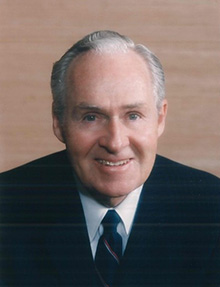
Click for PDF version of Robert Galvin -- Motorola -- Biography
Robert Galvin -- Motorola -- Wikipedia page
Introduction
 Picture of Robert Galvin - Motorola
Picture of Robert Galvin - Motorola
Bob Galvin (on the left) was named president of Motorola in 1956 and succeeded his father, Paul Galvin (on the right), as the chief executive officer in 1958. The company began life with Paul Galvin s development of a battery eliminator in 1928 followed by the development of an automobile radio in 1929. The battery eliminator had a very short life while the automobile radio became a profitable product for decades. Motorola subsequently expanded into two-way radio communications (e.g. police communications, military communications). Next came the company s entry into the production of television receiving sets and semiconductors. Motorola was prominent in all of those markets when Bob Galvin followed his father as CEO.
In addition to formal management training Bob Galvin learned the business by working in lower level jobs and by receiving mentoring from older employees. Among his most important mentors was Paul Galvin. And among the most important ideas passed on from father to son were Paul Galvin s two favorite sayings about building and maintaining an entrepreneurial culture. First, there was the saying that encouraged the entrepreneurial act Do not fear failure! In other words, entrepreneurs take risks and risk takers will inevitably experience some failures. Fear of failure can prevent a potential entrepreneur from taking risks. Second, there was the saying that kept those risks manageable Recognize the signs! In other words, recognize the possibility of failure and move quickly to cut losses once it is clear that a new project will not become profitable. When Paul Galvin died in 1958 these two admonitions were part of the philosophy which he left behind.
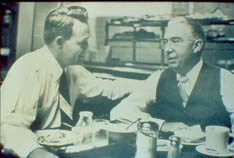 Picture of both father and son
Picture of both father and son
In 1986 Bob Galvin gave up the title of CEO while remaining chairman of the board. Between 1958 and 1987 sales had grown from $ 216.6 million to $ 6.7 billion and cash flow per share had grown from 89 cents to $6.10. Five years later Bob Galvin published The Idea of Ideas (Motorola University Press, 1991). There he presented a variety of ideas which influenced his ability to lead Motorola through more than three decades of successful growth and renewal. His father s legacy figured prominently in his writing. Perhaps the most telling insight in that regard is this statement, (M)y father treated me to the most demanding discipline. He trusted me! (p.6).
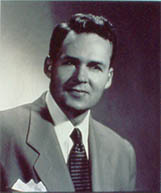 Picture of young Bob Galvin
Picture of young Bob Galvin
During his almost 30 year tenure as CEO Bob Galvin led Motorola through numerous renewal experiences. One was the transition from management by a founding entrepreneur to management by professionals who still retained some semblance of the entrepreneurial spirit. A second was the transformation of Motorola from a company which emphasized both consumer and industrial markets to one which focused on industrial customers. A third was to effectively respond to the Japanese challenges in the areas of quality management and business strategy. His was not a one-man show. Instead, Bob Galvin maintained an egalitarian culture in which managers at all levels were encouraged to develop a sense of proprietorship and a willingness to engage in open discussion.
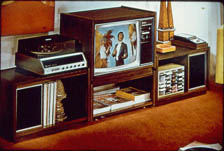 Picture of color Television
Picture of color Television
The history of Motorola s color television business illustrates Bob Galvin s application of his father s lessons on risk taking. The father had introduced a color television receiver in 1955 and then quickly withdrew it when he recognized the signs that it was too early to make a profit with that product. Bob waited until a profitable opportunity appeared in 1961 and reintroduced a color television receiver. The venture was profitable. But in the mid-1960s Bob began to closely study the Japanese consumer electronics industry and concluded that in the long run the Japanese would have a competitive advantage. And so Motorola developed an exit strategy and sold the television business to a Japanese firm. The proceeds were redeployed to Motorola s growth products for the future.
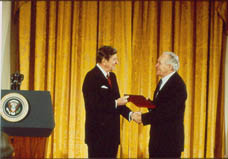 Picture of Bob and Ronald Reagan
Picture of Bob and Ronald Reagan
Meeting the Japanese challenge in the 1980s involved two separate issues. One was the Japanese competitors strategy of using cutting prices in the American market, keeping prices high in the Japanese market, and blocking the American competition from competing in the Japanese home market. Bob Galvin led American industry s response. That response consisted of enlisting the U.S. government in the rewriting of the rules of competition so as to eventually eliminate the Japanese home country sanctuary. The other issue with the Japanese was the fact that they had developed superior quality management tools. Bob Galvin insisted that Motorola would learn to match the Japanese. His leadership enabled Motorola to launch its then famous six-sigma quality management program. The company s success was recognized when the U.S. Government awarded Motorola one of the first Malcom Baldridge awards (U.S. President Ronald Reagan is shown here giving the award to Bob Galvin on the right).
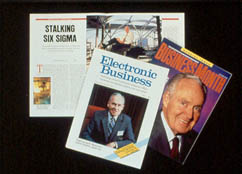 Picture of publicity
Picture of publicity
Motorola s success in implementing its total quality management program resulted in a flurry of good publicity. At a time when the American press expressed doubts about America s ability to compete, Motorola s success offered encouragement. Bob Galvin, himself, became a spokesman for American hopes. As he once put in, We in America can readily hold our own against excellent Japanese companies if we invest in research and development sufficiently and implement that research properly, if we invest in modern production techniques and use them, if we work very hard and very smart in our participative management processes and, furthermore, if we have at least the same quality expectations. (Grover Heiman , Competing with the Japanese, Nation s Business, November, 1982, p. 47).
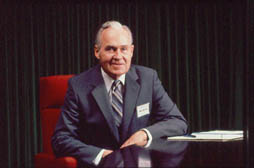 Picture of Bob Galvin
Picture of Bob Galvin
Business ethics was an important issue with Bob Galvin. Motorola s corporate statement on this matter read as follows for customers, employees, shareholders and community. (FOR) CUSTOMERS, (our objectives are) to serve every customer better than our competitors with products and services of excellent value and quality , and thereby earn continued enthusiastic trust and support. (FOR) PEOPLE (our objectives are) to treat each employee with dignity, as an individual; to maintain an open atmosphere where direct communication with employees affords the opportunity to contribute to the maximum of their potential and fosters unity of purpose with Motorola; to provide personal opportunities for training and development to ensure the most capable and effective work force; to respect senior service; to compensate fairly by salary and benefits and, where possible, incentives; and to practice the commonly accepted policies of equal opportunity and affirmative action. (FOR) SHAREHOLDERS, (our objective is) to have our shareholders prosper and, therefore, make our equity securities an attractive investment. (FOR THE) COMMUNITY, (our objective is) to be a good corporate citizen by contributing to the economic and social well-being of every community and country in which we operate. The corporation will encourage its employees to actively participate in community affairs. (For Which We Stand. A Statemelnt of Purpose; Objectives and Ethics. Schaumberg, Illinois, Motorola, Inc., May, 1986.
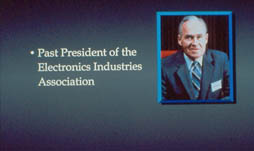 Picture of Past President of the Electronics Industries Association
Picture of Past President of the Electronics Industries Association
Bob Galvin s success in dealing with the Japanese business strategy of sancturary reflected his broader view that a company CEO should play a role in writing the rules by which firms in an industry compete. In fact, when talking to college audiences he sometimes would refer to the three topics of sanctuary, credentialing and writing the rules. Sanctuary, he would say, is what the Japanese achieve by preventing American entry into the Japanese home market. Re-writing the rules of international competition is what must be done in order to open up the Japanese market. But to convince the American Congress to rewrite the rules it is necessary for industry spokespersons to have credibility. To have credibility one must be credentialed. And to be credentialed an executive must have a track record of industry expertise. One of the ways Bob Galvin credentialed himself was to become active in industry trade association activities.
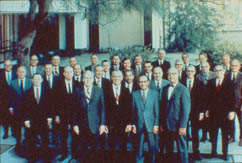 Picture of leaders
Picture of leaders
Bob Galvin s Motorola was truly an organization of proactive empowered leaders with a sense of proprietorship. It was an egalitarian culture which was maintained by Bob Galvin s constant role modeling and such techniques as addressing everyone on a first name basis, working in shirt sleeves and encouraging open discussion. With respect to the last point, management guru James O Toole approving quotes the following comment by a Motorola manager, The expectation is that you will challenge any idea. The top three guys Galvin, Weisz and Mitchell disagree with each other in front of their managers. The upshot is a healthy disrespect for the idea that those at the top are necessarily the wisest. (James O Toole, Vanguard Management, Doubleday and Company, 1985, p. 292). This emphasis on participative management was promoted throughout the company.
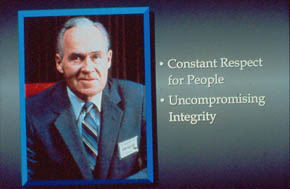 Picture of Bob and his philosophy
Picture of Bob and his philosophy
While disagreement was considered a healthy sign at Motorola, Bob Galvin insisted on constant respect for people and uncompromising integrity. The hoped for result was the kind of trust that leads to creativity and hence long run survival. Here is what Bob Galvin says about such trust in his The Idea of Ideas, One s creativity depends on interaction with others others one trusts others who feel trusted. For one to be unfettered in risking creative interaction with another, that other must know the trust of openness, objectivity and a complementary creative spirit. (p.12).
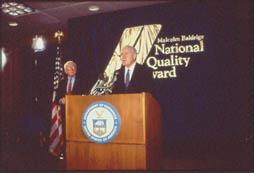 Picture of National Quality Award
Picture of National Quality Award
Motorola s Malcomb Baldridge recognition was a fitting tribute to the fruits of Bob Galvin s commitment to the concept of corporate renewal. In its simplest version corporate renewal refers to the process of changing what needs to be changed while retaining those elements of the company s heritage that still provide competitive advantage or survival value. In Motorola s case the element of corporate heritage that retained value was founder Paul Galvin s entrepreneurial principles --- (1) Reach out! Do not fear failure and (2) Recognize the signs (and cut your losses on risky ventures that aren t going to be profitable). One of Bob Galvin s most impressive accomplishments was his success in creating corporate renewal in a way that retained the founder's touch.
This article was written by Dr. Richard E. Hattwick
2 part videos of Robert Galvin
Video Part 1 Link
Video link to Part 1 - Legends - Robert Galvin --Motorola, Inc.
Video Part 2 Link
Video link to Part 2 - Legends - Robert Galvin --Motorola, Inc.
Copyright 2001 Illinois Business Hall of Fame. All Rights Reserved.
Copyright 2001 American National Business Hall of Fame. All Rights Reserved.











